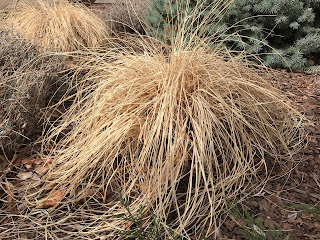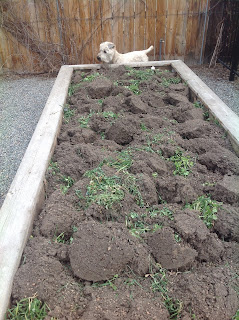 |
| Get After the Weeds! |
General Outdoor –
- Walk around the landscape taking in the welcome signs of spring– bulbs of snowdrops, crocus and winter aconite. Plan on protecting blooming bulbs with a weighted plastic bucket, heavy box or container prior to heavy snows to prevent the flowers from damage. If stems get broken, cut remaining flowers and enjoy indoors in a vase.

- Less commonly planted perennials such as Hellebores known as “winter roses,” or the Lenten rose (known for blooming around Easter), provide long awaited colors of pink purple and white.
- Stay out of perennial or vegetable beds if the ground is frozen or still wet. There’s time to cut back foliage and rake leaves when things dry out. Fall planted perennials and shrubs like roses benefit with added protection from freeze/thaw cycles when foliage and leaves are left in place from the fall. Wait until late April to May to do any pruning.
- Cut back ornamental grasses to a few inches above the crown in late winter. Use twine or rope to keep them intact while cutting. Use either sharp shears or pruners, or hedge/electric shears and wear long sleeves and gloves for protection. If areas have died out, remove the entire plant (if doable) and cut out healthy sections to replant or share. If the root ball is too large, just dig out healthy sections and replant. You can plant where it has died out, just be sure to dig out the dead section, again, if doable.
- Finish up dormant shrub and tree pruning in March. Pruning damaged, diseased or dead wood in the winter is recommended, along with reducing tree canopy size if trees are touching houses or interfering with pedestrian or automobile traffic. Pruning thin wooded trees like silver maples may prevent limbs from splitting or being damage from late spring snow storms. Careful to not remove more than one third of the tree canopy in one year.
- Trees that leak sap after pruning including maple, elm, aspen, and birch should be pruned in early winter. Sap flow or bleeding will not harm the tree. Read more here.
- Prune fruit trees in late winter before bud break. Read more about training young fruit trees here. Read more about training mature fruit trees here.
- What not to prune in late winter–roses, wait until late April or into May. Any early pruning will stimulate growth and often times that new growth gets zapped by cold weather. Spring flowering shrubs like lilac, quince and forsythia should be pruned right after bloom.
- If annual weedy grasses like crabgrass are yearly problems, apply pre-emergent herbicides for control in March or early April. More here.

 |
| Turned over cover crop on 3-4-2016 |
- If the soil isn't too wet or frozen, turn over fall planted cover crops to allow plenty of time for it to break down for spring planting.
- The cool season vegetable planting month has arrived, that is if snow isn’t on the ground and the soil can be worked (not too wet, crumbly is best). Get a jump on early planting by warming the soil with plastic then using row covers, cloches or tunnels to protect the seeds and plants.
- Hardy cool season crops such as spinach, peas, arugula and kale will germinate in soils that are 45 degrees. A soil thermometer is an inexpensive investment and tells you when it’s go time.
- The planting bed should be ready to plant, no clods or left over plants or roots from last fall. Warm up the soil with black plastic for a couple of weeks. Remove the plastic, then plant seeds of leafy greens, peas or transplants which is just another term for young plants that are 4-6 weeks old of "hardened off" broccoli, cabbage, Brussels sprouts and cauliflower.
- Water the bed or transplants and cover each night when frost or snow is expected with the thickest floating row covers or plastic tunnels or cloches. Be sure to remove plant coverings the next day when temperatures reach 40.
- No worries if Mother Nature doesn’t allow for early March planting of cool season veggies - plant when the soil can be worked - hopefully before mid-May!
Perennial/Annual Seed Starting –
- Perennial seeds can easily be started indoors for transplanting outdoors later in the spring. Since perennial plants come back year after year, purchasing seeds versus a container grown plants is money well spent (less money that is). Many seed started perennial plants bloom the first year they are planted.
- Check the garden centers for perennial seeds, read the packet for best times to start indoors for transplanting later in the spring or summer. Look for – agastache, alyssum basket of gold, bee balm, columbine, coreopsis, rudbeckia, little bluestem grass and many more.
Houseplants –
- As the days get longer with more light, houseplants are responding happily with new growth.
- It’s a good time to re-pot root bound plants, take cuttings and start new plants for yourself or to share with others.
- Signs of root
bound plants include roots coming out of the bottom of the container,
dried out soil or little soil left and need for frequent watering.
Some plants prefer to be in tight quarters including African violets, peace lily, spider plants, ficus, jade plants, aloe, asparagus ferns and Christmas cactus. They like being root bound so the plant focuses on growing more side shoots or bloom versus leaf growth. - When re-potting use a slightly larger clean container with sterile potting soil. Place a piece of nylon or a coffee filter over the bottom hole instead of pebbles or broken clay pieces. This gives more space for roots. Carefully turn over the pot and tamp out the root ball.
- If the roots are circling the inside of the pot, use a sharp knife and make cuts on each side and bottom of the plant to force the roots to grow into the new soil.
- Place some new soil on the bottom of the container and around the sides once the plant is in the container. Water well, no need to fertilize for at least a month.
Additional Resources –
Seeding and Planting Charts for Ornamental Annuals, Herbs, Cool-Season Vegetables and Warm Season Vegetables
Warming Up Outdoor Planting Bed Video
Making Inexpensive Hoop Houses for Early Planting Video
No comments:
Post a Comment
Note: Only a member of this blog may post a comment.